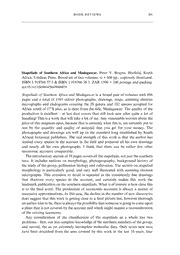
Stapeliads of Southern Africa and Madagascar. Peter V. Bruyns PDF
Preview Stapeliads of Southern Africa and Madagascar. Peter V. Bruyns
BOOK REVIEWS 201 Stapeliads of Southern Africa and Madagascar. Peter V. Bruyns. Hatfield, South Africa:UmdausPress.Boxedsetoftwovolumes,vi+606pp.,copiouslyillustrated. ISBN 1 919766 37 5 & ISBN 1 919766 38 3. ZAR 1500 + 240 postage and packing. doi:10.1017/S0960428609000079 Stapeliads of Southern Africa and Madagascar is a boxed pair of volumes with 606 pages and a total of 1385 colour photographs, drawings, maps, scanning electron micrographs and cladograms covering the 20 genera and 182 species accepted for Africa south of 17°S plus, as is clear from the title, Madagascar. The quality of the production is excellent – at last dust covers that still look new after quite a lot of handling!Thisisaworkthatwilltakealotofuse.Anyreasonableworriesaboutthe priceofthismagnumopus,becausethatiscertainlywhatthisis,arecertainlyputto rest by the quantity and quality of material that you get for your money. The photographs and drawings are well up to the standard long established by South African botanical publishers. The real strength of this work is that the author has studied every species in the account in the field and prepared all his own drawings and nearly all his own photographs. I think that there can be rather few other taxonomic accounts comparable. Theintroductorysectionof58pagescoversallthestapeliads,notjustthesouthern taxa. It includes sections on morphology, phytogeography, background history of thestudyofthegroup,pollinationbiologyandcultivation.Thesectiononstapeliad morphology is particularly good, and very well illustrated with scanning electron micrographs. This attention to detail is repeated in the consistently fine drawings that illustrate every species in the account, and certainly makes this work the landmarkpublicationonthesouthernstapeliads.Whatisofinterestishowclosethis is to the final word. The production of taxonomic accounts is always a matter of successiveapproximations.Inthiscase,thedeclineinthenumberofnewdiscoveries does suggest that this work is getting close to a final picture but, however thorough anauthortriestobe,thereisalwaysthepossibilitythatsomeoneisgoingtocomeupon aplantthatisnotcoveredbytheaccountandwhichmightrequireareconsideration of the existing taxonomy. Any consideration of the classification of the stapeliads as a whole has two problems–first,ourlesscompleteknowledgeofthenorthernmembersofthegroup, and second, the as yet extremely incomplete molecular data. Only seven new taxa have been described from the area covered by this work in the last 10 years, four 202 BOOK REVIEWS species and three infraspecific taxa, which does indicate that knowledge of the southern members of the group must be approaching completion. However, one of those newspeciesrepresentedtheratherdistinctnewgenusBaynesia,sotherecould be further surprises, but novelties on the scale of those still being described from northoftheareacovered,where25newtaxaweredescribedwithinthesameperiod, are clearly not going to happen. But even in the north, knowledge is perhaps not quiteasbadasBruynssuggestsonp.575astherehasbeenareductionintherateat whichnewtaxahavebeendiscoveredsincethe1970sand1980swhilstthenumberof possible new genera is small, especially if one does not follow the ‘ultrasplitty’ treatment of Caralluma by Plowes (1995). There will probably be changes in the details of interpretation, particularly with regardstogenericdelimitationandtoalesserdegreetherankoflowertaxa,andthe author is to be commended for drawing attention to situations where there is still uncertainty such as the decision to restrict Lavrania to a single species and not to includeallthespeciesofLarryleachiaashehaddonepreviously.However,thiswork must be getting rather close to the final picture of the southern stapeliads and whatever might happen in the future, such as, perhaps, a reconsideration of such awidelydrawnOrbea,everyoneisgoingtohavetoreferbackto‘Bruyns’andjustify any changes against his standard. The introduction of molecular data has very greatly influenced modern plant systematics. Such data have been of particularly great value in groups such as the stapeliads in which the morphological data are restricted as a result of selection for succulence.Unfortunatelyithasbeenmoredifficultthanusualtoobtaininformative DNA sequences from the stapeliads. Data collection has been slow and the results still remain much too fragmented to justify making formal changes in taxonomy. Meve & Liede (2002) have presented what has to be considered a preliminary analysis of some 67 species but the level of sampling is surely too low to justify making the formal changes in generic delimitation that they proposed. Bruyns indicates that he is gathering more such data but, more wisely, declined to make explicit use of it at this stage. He does present cladograms based only on mor- phologicaldataforeverygenusbutthenumberofcharactersavailableisratherfew andone doesquestion thestability ofsome ofthe cladograms obtained. Only afew changes in the interpretation of particular characters could have quite a large effect on the resultant cladogram. Arethereanypartsofthismagnumopusopentocriticism?Onehastolookrather hardtofindanyillustrationsthatarelessthanexcellent,perhapsoneortwohabitat views that look as if they were made from rather old and slightly faded original slides. Every taxon is mapped, genera often as area maps. Those of strictly South African taxa showing the number of species per unit area are excellent as is to be expected for South Africa which is much better mapped than anywhere else within the overall range of the stapeliads. Those of the more widely distributed genera, however,arerathercrudeandsometimesmisleading–certainlythemapshowingthe overall distribution of stapeliads is misleading as it seems to suggest the occurrence BOOK REVIEWS 203 ofstapeliadsthroughoutthedenseforestsofSWEthiopia.Alotoftheforestmight have gone but the rainfall is still much too prolonged to be survived by any normal stapeliad. The maps of individual species are much better as they are well-designed dotmapsgivingaratherexactrepresentationofthedistribution.Thereisaseriesof errors for Stapelianthus, however, where all the maps are identical: an error has led to each species being illustrated by the map for the genus as a whole. I very much doubt that the author was responsible! Perhaps the least satisfactory section is that onthehistoricalbackground.Thisisobviouslyinspiredbytheverydetailedaccount provided by the previous landmark work on the group, White & Sloane’s The Stapelieae(White&Sloane,1937),andsuffersbycomparison.Itwouldhavebeenso much better if it could have provided a comparable systematic update of the personalities involved in the collection and study of the southern stapeliads in the seventyoddyearssince‘WhiteandSloane’ratherthanananecdotalcommentaryon justaselection,ignoringotherverysignificantcontributorstoourknowledge.There is extra information about quite a number of further collectors included under the taxathattheycollectedbutthisisonlyeasilylocatedwheretheyhappentohavehad a taxon named after them. This work is a significant landmark in the history of the stapeliads, up there with Masson(1796)whofirstmadepeopleawareofthewondersofthegroupandWhite & Sloane (1937) who drew such a lot of information together. ‘Bruyns’ is definitely a publication that will be lusted after for years to come. References Masson,F. (1796).Stapeliænovæ. London:G. Nicol. Meve, U. & Liede, S.(2002). Amolecular phylogenyandgenericrearrangement of the stapelioid Ceropegieae (Apocynaceae:Asclepioideae). Pl.Syst. Evol. 234: 171–209. Plowes, D. C. H.(1995). Areclassification ofCaralluma R. Br. (Stapelieae: Asclepiadaceae). Haseltonia 3: 49–70. White,A. &Sloane,B. L.(1937).TheStapelieae,2ndedition.USA:AbbeySanEncino Press. M. G. Gilbert
